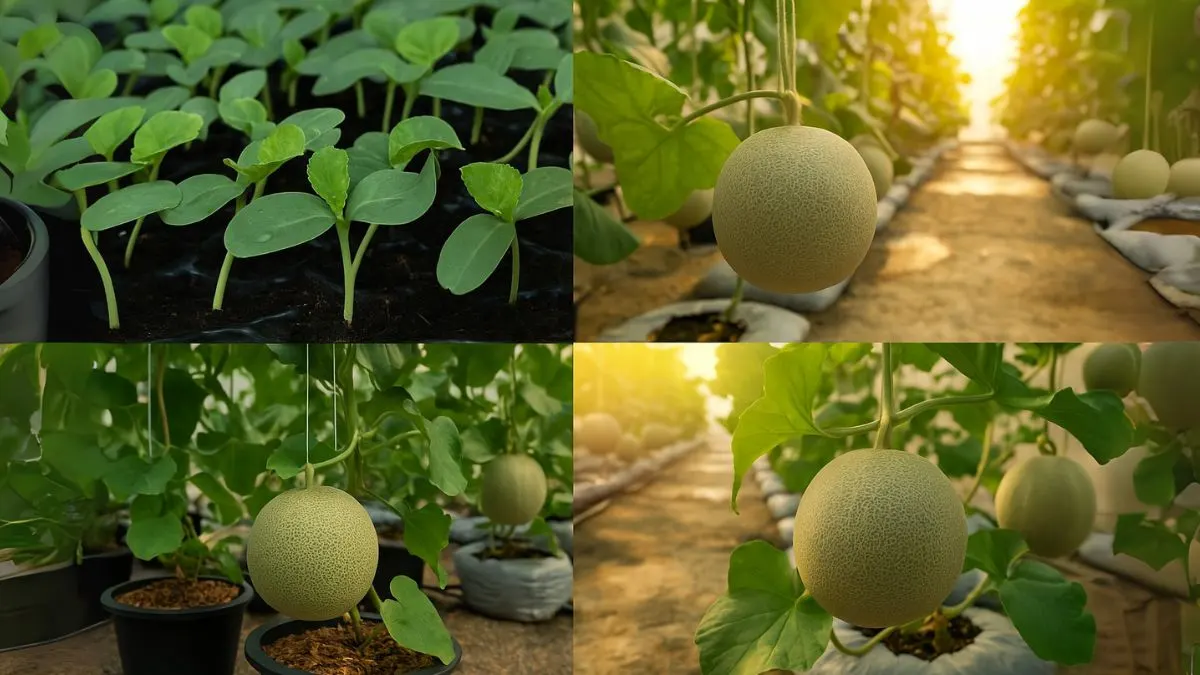Nothing tastes quite like a freshly harvested cantaloupes from your own garden. Sweet, juicy, and refreshing, this fruit is not only delicious but also rewarding to grow. While many people buy cantaloupes from the market, learning to grow cantaloupe vines from seed gives you the satisfaction of knowing exactly how your food was grown. With the right soil, warmth, and patience, you can enjoy homegrown melons by mid-summer.
Choosing the Right Conditions

Cantaloupes are warm-season crops. They need heat and sunshine to thrive. Always remember: cantaloupes thrive in warm, sunny locations with plenty of moisture, sunlight, and heat.
- Soil requirements: Make sure you plant seeds directly in warm, fertile, well-drained soil when the soil temperature is at least 65°F.
- Ideal sprouting: They sprout best once the soil temperature is at least 70°F.
- Spacing: Whether sowing directly outdoors or transplanting, plant in mounds 4 feet apart to give the vines room to spread.
A tip from my own garden—adding compost to the planting mound not only boosts fertility but also helps retain just the right amount of moisture.
Starting Cantaloupe Seeds
You can either start indoors or sow seeds outdoors, depending on your climate.
- Indoors: Begin by placing seeds on a clean, dry kitchen tissue paper to pre-germinate them. Once sprouted, transplant them into small pots until they are strong enough to move outside.
- Outdoors: Direct sowing is often easier if your region warms up quickly. Put 4-6 seeds in each hill about one inch deep into the soil. Thin them later, keeping the healthiest seedlings.
Remember, seeds should be planted 1-2 inches deep, in mounds 4 feet apart, whether indoors or outdoors.
Also Read: How to Grow Pumpkins for a Big, Festive Fall Harvest
Caring for Young Seedlings
Once seedlings emerge, they need consistent care:
- Watering: Keep the soil evenly moist, but avoid waterlogging. Cantaloupes don’t like soggy conditions.
- Mulching: Adding mulch around the base helps retain soil moisture and keeps weeds away.
- Transplanting: If you’ve started indoors, transplant your seedlings outside only after all danger of frost has passed.
It’s also worth noting that seedlings should be planted in warm, fertile, well-drained soil to prevent stunted growth.
Growth and Maintenance
Patience is key when growing melons. You’ll expect at least 90 days from germination to first harvest, so plan accordingly.
- Sunlight: These plants crave sun. Place them in a location that receives at least 6-8 hours of direct sunlight daily.
- Watering: Cantaloupes need plenty of moisture, sunlight, and heat, but reduce watering once the fruits start maturing to enhance sweetness.
- Training the vines: Some gardeners allow them to sprawl across the ground, while others train them up trellises to save space.
Pollination and Fruit Development
Cantaloupes rely heavily on pollinators like bees. Without them, your flowers may not set fruit. If you don’t notice natural pollination happening, you can hand-pollinate using a small brush to transfer pollen from male to female flowers.
Once pollinated, fruits develop rapidly, swelling into the iconic netted melons we love. To avoid rot, place ripening fruits on straw or cardboard rather than leaving them directly on the soil.
Common Challenges and Solutions
Like all plants, cantaloupes have their share of challenges.
Problem |
Cause |
Solution |
Yellow leaves |
Overwatering or poor drainage |
Ensure well-drained soil |
No fruit set |
Lack of pollinators |
Encourage bees or hand-pollinate |
Small melons |
Poor nutrition or spacing |
Add compost and allow enough space |
Rotting fruits |
Excess water on soil surface |
Use mulch and reduce watering at ripening stage |
A personal tip: I once lost an entire crop to powdery mildew because I didn’t provide good airflow. Now, I always leave enough space between plants and avoid overhead watering.
Also Read: Why Avocados Are Called Nature’s Butter Fruit
Harvesting Cantaloupes
The wait is worth it. By late summer, your melons will be ready. Signs of ripeness include:
- A sweet fragrance near the stem.
- Skin color changing to a golden tan.
- Fruit easily slipping off the vine with gentle pressure.
When picked at the right time, homegrown cantaloupes are far juicier and sweeter than store-bought ones.
Growing cantaloupe is a journey of patience and reward. From sowing seeds to harvesting, every step brings you closer to enjoying one of nature’s sweetest gifts.
👉 Whether you’re in the U.S., Canada, or anywhere with a warm growing season, try starting your own cantaloupe patch this year. The first juicy bite of a melon you’ve grown yourself will make all the effort worthwhile.






